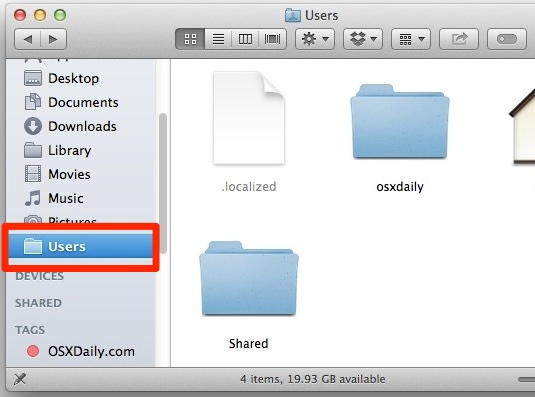What is the usr folder?
- How To Access User Library Folder On Mac
- Find User Folder On Mac
- Access Library In User Folder Mac Pro
- Access Library In User Folder Mac Pro
- Library Folder In Mac
Apple operating systems are constructed using a Linux file system hierarchy, which means that traditional UNIX system directories hide certain files and directories. Unlike Applications or Documents or Downloads, some files and folders are hidden by default by the Mac operating system (macOS).
Jun 10, 2015 Up to OS X 10.7 Lion, accessing the Library folder was quite simple; all you needed to do is navigate to your Home folder, and from there you could access the Library folder. But from OS X 10.8 onwards, Apple has hidden the Library folder, meaning it won’t show up in your Home folder anymore. Mar 29, 2019 How to Find the Library Folder on a Mac. This wikiHow teaches you how to force your Mac's user 'Library' folder to show up in the Finder window. While the 'Library' folder is hidden by default, you can prompt it to appear both temporarily. The easiest way to get to the Library for a particular user is to be logged on as that user, open Finder, go to the Finder 'Go' menu in the menu bar at the top of the screen and hold down the Option key for Library to appear. You can navigate to the Users folder by opening finder and double-clicking Users at the bottom of the Finder window. By default, the User Library folder is hidden in Mac OS 10.7 and above. We'll cover a few different methods to easily access this hidden folder. The User Library is home to many 'under the hood' files and folders that correspond to the various Apps and system processes in your computer. To permanently show all hidden files: Press return. Press Option and right-click the Finder icon in the dock and click Relaunch. To hide files again, use the Terminal command.
MacOS hides these for good reason. When buildings are constructed, wiring and plumbing is hidden behind walls. As a general rule, exposing anything that could have a serious negative impact on a building if it was accidentally damaged or tampered with is considered a good idea. The same is true of usr and var and other folders and directories.
Usr used to mean “everything user related”, but over time this has evolved into “user usable programs and data.” What this means is, the usr contains shareable, read-only data, and often contains the largest share of behind-the-scenes data on any operating system. Within the usr is user-land programs and data is contained, such as user binaries, their documentation, libraries, header files, and other read-only programs and associated data.
Generally speaking, because these folders and directories are behind the scenes, most users - even Mac power users - don't need to know about them or gain access. Similar to plumbing and wiring, it is enough to know they're running smoothly and only to gain access if you know what you’re doing, or let an Apple trained expert take a look using diagnostic software to see if there are any problems within the usr files and directories.
Another way to make sure everything is working smoothly under the hood is to download a Mac performance improvement app, such as CleanMyMac X. It can take a quick look at what is taking up too much space on your hard drive, with its Space Lens feature. Once CleanMyMac X has analysed your files and directories, including those that are hidden from view, you can delete what it recommends and regain the space you need for your Mac to run smoothly and quickly.
With the Space Lens tool, you can also access the usr folder and see how much space it takes on your Mac and what files it includes. First, you have download and install CleanMyMac X and then follow such steps:
- Launch the app.
- Go to the Space Lens tab.
- Click Scan.
- Find usr folder in the list.
- Double click to review the files.
However, if you prefer the manual way of looking behind-the-scenes, here is how you can access the usr folder on a Mac.
How to access the usr folder: The manual way

If you want to access the usr folder, there are a couple of ways you can do that.
How To Access User Library Folder On Mac
1. Navigate to the usr through the Finder
- Open Finder.
- Press Command+Shift+G to open the dialogue box.
- Enter what you want to search for, e.g. /usr or /usr/discreet.
- Now you should have temporary access, and this means that you should be able to drag the folder into the Finder favourites bar for easier access in the future.
Another way to gain access is through Terminal.
2. Finding usr in Terminal
- Launch Terminal; which you can find in /Applications/Utilities
- Enter this command in Terminal:
chflags nohidden ~/usr - (If nothing shows up under that name, try /Library as an alternative)
- Click Return. Make sure the command is executed.
- Quit Terminal. The usr folder should be visible in the Finder.
- If you ever want to restore this to how it was before enter the following command in Terminal:
chflags hidden ~/usr - Click Return again and it should be back to how it was.
Only attempt this method if you are comfortable using Terminal. Remember, using Terminal can make significant changes to your macOS systems and files, so only make changes this way if you consider yourself a Mac power users. This method should temporarily uncover the usr folder.
Accessing the usr folder is often only necessary if you are looking for ways to improve the performance or speed of your Mac. Thankfully, there is an easier way. Downloading CleanMyMac X can solve a lot of problems, quickly and safely, without any risk of causing accidental damage. It comes with a useful Space Lens feature, since one reason a Mac doesn't perform as well as it once did is a result of files taking up too much space, or duplicate files, folders or apps. And identifying what is causing space issues is the job that CleanMyMac X does so well. See for yourself!

Learn how to access the hidden Library folder in your Home folder on your Mac so you can tweak app settings and access app files.
Inside the home folder on your Mac is a Library folder that stores app-specific files and settings, personal settings, and some data. The files and settings in the Library folder should be left alone for the most part. But, you may want to tweak the settings for an app, which may require accessing the Library folder. Or, maybe an app backs up data to the Library folder and you want to copy that to an external drive.
As of Mac OS X Lion (10.7), the Library folder in your home folder is hidden by default. That doesn’t mean you can’t get to it. It’s hidden so you don’t accidentally delete settings and data, damaging apps in the process. So, if you decide you want to access the Library folder, be very careful.
Today we’re going to cover different ways of accessing the hidden Library folder in your home folder and how to make it permanently available in Finder.
What is the Path to the Library Folder?
Find User Folder On Mac
The Library in your home folder is written as ~/Library. The tilde (~) character is a shortcut for your home directory. For example, on my Mac, that would expand to /Users/lorikaufman/Library.
Access the Library Folder Using the Go to Folder Option
If you want to access the Library folder only occasionally, you can use the Go to Folder option in Finder.
Open Finder or just click on the desktop. Head to Go > Go to Folder, or hit Cmd + Shift + G.
Type:~/Library in the Go to the folder box on the dialog box and click Go or press Enter.
If you have one or more Finder windows open, the Library folder opens in the currently active window. If no Finder windows are open, a new one opens to the Library folder.
Access the Library Folder Using the Terminal
If you prefer using the command line, you can access the Library folder using the Terminal.
Access Library In User Folder Mac Pro
Go to Utilities > Terminal in the Applications folder. To access the Library folder directly in the Terminal, type:cd ~/Library at the prompt to switch to the Library folder.
You can type:ls at the prompt to get a detailed folder listing. You can work with the files in the Library folder directly on the command line. Just be careful.
You can also use the Terminal to open the Library folder in a Finder window. Type:open ~/Library at the prompt and hit Enter.
Access Library In User Folder Mac Pro
Access the Hidden Library Menu Option in Finder
The Library folder is available on the Go menu in Finder, but it doesn’t show on the menu by default.
To temporarily show the Library option on the Go menu, open the menu and press the Option key. The Library folder shows up between Home and Computer on the Go menu. Keep the Option key pressed while you move your mouse down the menu and select Library.
If you’re using a Windows keyboard with your Mac, press the Alt key.
Show the Library Folder Permanently in Finder
If you access the Library folder often, you can permanently show the Library option on the Go menu and the Library folder in your Home folder.
Open Finder and head to your Home folder using the left pane or by pressing Cmd + Shift + H. Then, go to View > Show View Options, or hit Cmd + J.
A dialog box displays with options you can set for your Home folder. Check the Show Library Folder box at the bottom of the dialog box. The Library folder now shows up in your Home folder in Finder windows and the Library option becomes permanently available on the Go menu.
When you permanently show the Library folder in Finder, you can hit Cmd + Shift + L to open it in a Finder window, in addition to selecting the Library option on the Go menu.

Happy Tweaking, But Be Careful
Library Folder In Mac
The Library folder is hidden by default for a good reason. So, before tweaking settings and changing files in the Library folder, make sure you know what you’re doing.